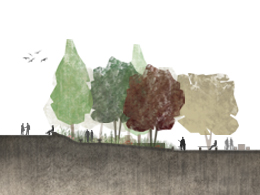STUDENTS PROJECTS
PROJECTS2013
Students: Vavanou Antonia, Taroudaki Kallirroi
Supervisor Professors: Karvountzi Valentini, Klampatsea Irini
Advisor Professors: Efesiou Irini, Papaioannou Maria
School of Architecture, NTUA
Presentation date: 7 November 2014
The main purpose of this thesis project is to create a modern park in the center of Athens, and specifically in the area of Kountouriotika. Apart from green space, it includes multiple uses for all ages, focusing on young people.
The study area
The study area belongs to the 7th arrondissement of Athens. It is an area of 21 acres, situated behind the stadium of Panathinaikos on Alexandras Avenue, under the Lycabettus Hill. The motive for our choice was a walk we took in the area and we were impressed by the fact that such an area in the city center, was unstructured, with nature being in a wild state.
Current situation
The area is divided into two parts by Michail Melas street. At the lower part there are sports fields, a playground and a skatepark, while in the upper, the area is as described, abandoned and largely unstructured. The point is that although it is a common area, it is used by individual user groups, without having a single identity.

Concept
After consulting urban analysis of the surrounding area, and studying both spatial and qualitative characteristics, the design arises experientially, from our internal perception of the location and its identity.

Existing buildings and the planting site are part of the city and the history of the area, and they interact with each other. That's why we need to include them in the designing process.

Our concept is to include too paths:
A short and clear path from which one sets up the perception of space and can quickly cross the park.
A wandering path, allowing a walk across the park that lenghtenss the experience of movement.
Flowing nature: We found interesting the part of wild nature and we chose to maintain a part in this situation, that flows through the park. So we have two different types of movement and how nature is organized or organizes space.

Uses
We were very concerned about how and for whom we design an urban park today, during the economic crisis period, so our solution would be realistic and reflect the current situation. The uses we choose have emerged after a research on existing structures of solidarity, which can be used by all kind of participants and are collective.

We retained the existing uses of basketball and volleyball court, playground and skatepark on the lower part, and improved the design. Also we added an outdoor fitness area. On the upper part, we chose collective and cultural uses, such as, a collective kitchen, urban cultivation and an outdoor amphitheater. We also put a building that focuses on promoting youth work and action, which has learning classrooms , electronic library, promotion offices and auditorium for multiple events. An underground parking for 60 cars is provided, to serve park visitors. The park will be managed by local people, organized in groups of collegiality.

designing - boundaries
We retain Michail Mela street, but we remove the car traffic and we change the material from hard to soft, in order to be an extra path under the existing trees.

Managing the limits was another part of the designing process. On the south, planting zones create a transitional zone of heights, between the tall buildings and the park. On the north side, the limit is our builidng, at a distance from the neighboring building. A green wall is set in between, giving the impression that the whole area of nature does not end in the building, but stands up like a carpet against the wall. The roofs of the building are planted, in order to be part of the landscape, but also for bioclimatic reasons.

On the main route we imagined an aerial path, which enriches the visitor's experience of space. At the same time, it serves the movement of people with disabilities through the park, allowing them to reach all levels and activities. It also allows a visual contact with Lycabettus Hill, which is almost nonexistent at ground level.

Planting is an essential structural element. We choose mostly native plants, with small water requirements, taking into account the shading of the plot during the year, for their better placement.
The materials of the ground are both hard and soft and are suitably combined to express the two main tracks of short route and wandering path, with curds and dilutions.












